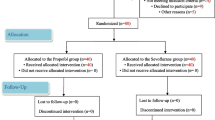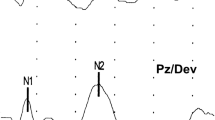Abstract
Purpose
Aminophylline accelerates the recovery from sevoflurane anesthesia. We studied the effects of escalating doses of aminophylline on cognitive and clinical recovery after sevoflurane anesthesia.
Methods
After ethical approval and informed consent, 150 patients scheduled for elective surgery under sevoflurane-fentanyl anesthesia were randomly allocated to receive saline or 2, 3, 4 or 5 mg/kg of aminophylline (n = 30 for each) at the end of anesthesia (T 0). Short Orientation Memory Concentration Test (SOMCT) scores, entropy values, end-tidal sevoflurane concentrations (EtSevo), times to eyes opening and extubation, respiratory rate (RR) and tidal volume (TV) were recorded.
Results
Compared to placebo, patients receiving 2, 3, 4 and 5 mg/kg of aminophylline had higher SOMCT scores [median (25th percentile/75th percentile) 20.6 (19/23), 21.5 (21/22), 24.5 (24–25), 25.5 (25/26), respectively, vs. 13.5 (13/14) at 30 min after extubation, and 24 (22/26), 25 (24/26), 27.5 (27–28), 27.5 (27/28), respectively, vs. 18.5 (18/19) at 45 min after extubation], higher entropy values for the first 10 min after T 0, lower EtSevo for the first 4 min after T 0, shorter times to eyes opening [5 (4.0/6.0), 5 (4.0/6.0), 4 (2.0/5.5), and 4 (2.0/6.0), respectively, vs. 9.8 (8.0/11.0) min], shorter times to extubation, shorter times to home discharge (P < 0.001), and higher RR and larger TV values. Patients who received 4 and 5 mg/kg of aminophylline showed higher SOMCT scores, 6 min shorter times to eyes opening and to extubation, and 58 min shorter times to home discharge.
Conclusion
The administration of escalating doses of aminophylline accelerates postoperative cognitive recovery from sevoflurane anesthesia, as measured by the SOMCT, due to increased ventilatory elimination of sevoflurane.



Similar content being viewed by others
References
Biedler A, Juckenhöfel S, Feisel C, Wilhelm W, Larsen R. Cognitive impairment in the early postoperative period after remifentanil-propofol and sevoflurane-fentanyl anesthesia. Anaesthesist. 2000;49:286–90.
Bronco A, Ingelmo PM, Aprigliano M, Turella M, Sahillioğlu E, Bucciero M, Somaini M, Fumagalli R. Xenon anaesthesia produces better early postoperative cognitive recovery than sevoflurane anaesthesia. Eur J Anaesthesiol. 2010;27:912–18.
Mahajan VA, Ni Chonghaile M, Bokhari SA, Harte BH, Flynn NM, Laffey JG. Recovery of older patients undergoing ambulatory anaesthesia with isoflurane or sevoflurane. Eur J Anaesthesiol. 2007;24:505–10.
Tas PW, Eisemann C, Roewer N. Indirect activation of adenosine A1 receptors in cultured rat hippocampal neurons by volatile anaesthetics. Eur J Anaesthesiol. 2005;22:694–702.
Bilotta F, Doronzio A, Cuzzone V, Caramia R, Rosa G, PINOCCHIO Study Group. Early postoperative cognitive recovery and gas exchange patterns after balanced anesthesia with sevoflurane or desflurane in overweight and obese patients undergoing craniotomy: a prospective randomized trial. J Neurosurg Anesthesiol. 2009;21:207–13.
Hüpfl M, Schmatzer I, Buzath A, Burger H, Hörauf K, Ihra G, Marhofer P, Nagele P. The effects of aminophylline on bispectral index during inhalational and total intravenous anaesthesia. Anaesthesia. 2008;63:583–90.
Wu CC, Lin CS, Wu GJ, Lin YH, Lee YW, Chen JY, Mok MS. Doxapram and aminophylline on bispectral index under sevoflurane anaesthesia: a comparative study. Eur J Anaesthesiol. 2006;23:937–41.
Turan A, Memis D, Karamanlyodthlu B, Pamukcu Z, Sut N. Effect of aminophylline on bispectral index. Acta Anaesthesiol Scand. 2004;48:408–11.
Turan A, Memis D, Karamanlioglu B, Colak A, Pamukcu Z, Turan N. Effect of aminophylline on recovery from sevoflurane anaesthesia. Eur J Anaesthesiol. 2002;19:452–56.
Krintel JJ, Wegmann F. Aminophylline reduces the depth and duration of sedation with barbiturates. Acta Anaesthesiol Scand. 1987;31:352–56.
Jagers JV, Hawes HG, Easton PA. Aminophylline increases ventilation and diaphragm contractility in awake canines. Respir Physiol Neurobiol. 2009;167:273–80.
Katzman R, Brown T, Fuld P, Peck A, Schechter R, Schimmel H. Validation of a short Orientation-Memory-Concentration Test of cognitive impairment. Am J Psychiatry. 1983;140:734–43.
Riad W, Schreiber M, Saeed AB. Monitoring with EEG entropy decreases propofol requirement and maintains cardiovascular stability during induction of anaesthesia in elderly patients. Eur J Anaesthesiol. 2007;24:684–92.
Aldrete JA. The post-anaesthesia recovery score revisited. J Clin Anesth. 1995;7:89–91.
Philip BK, Kallar SK, Bogetz MS, Scheller MS, Wetchler BV. A multicenter comparison of maintenance and recovery with sevoflurane or isoflurane for adult ambulatory anesthesia. The Sevoflurane Multicenter Ambulatory Group. Anesth Analg. 1996;83:314–23.
Vakkuri A, Yli-Hankala A, Sandin R, Mustola S, Høymork S, Nyblom S, Talja P, Sampson T, van Gils M, Viertiö-Oja H. Spectral entropy monitoring is associated with reduced propofol use and faster emergence in propofol-nitrous oxide-alfentanil anesthesia. Anesthesiology. 2005;103:274–83.
Aho AJ, Lyytikäinen LP, Yli-Hankala A, Kamata K, Jäntti V. Explaining entropy responses after a noxious stimulus, with or without neuromuscular blocking agents, by means of the raw electroencephalographic and electromyographic characteristics. Br J Anaesth. 2011;106:69–76.
Morgaz J, Granados MD, Domínguez JM, Navarrete R, Fernández A, Galán A, Muñoz P, Gómez-Villamandos RJ. Evaluation of spectral entropy to measure anaesthetic depth and antinociception in sevoflurane-anaesthetised Beagle dogs. Vet J. 2011;188:352–57.
Kesecioglu J, Rupreht J, Telci L, Dzoljic M, Erdmann W. Effect of aminophylline or physostigmine on recovery from nitrous oxide-enflurane anaesthesia. Acta Anaesthesiol Scand. 1991;35:616–20.
Johr M. Postanaesthesia excitation. Paediatr Anaesth. 2002;12:293–98.
Cohen I, Finkel J, Hannallah R, Hummer K, Patel K. Rapid emergence does not explain agitation following sevoflurane anaesthesia in infants and children: a comparison with propofol. Paediatr Anaesth. 2003;13:63–70.
Mato M, Pérez A, Otero J, De Antonio P, Márquez C, Torres L. Incidence of postoperative shivering in relation to the time of sevoflurane discontinuation. Rev Esp Anestesiol Reanim. 2002;49:197–200.
Larsen B, Seitz A, Larsen R. Recovery of cognitive function after remifentanil-propofol anesthesia: a comparison with desflurane and sevoflurane anesthesia. Anesth Analg. 2000;90:168–74.
Bilotta F, Caramia R, Paoloni FP, Favaro R, Araimo F, Pinto G, Rosa G. Early postoperative cognitive recovery after remifentanil-propofol or sufentanil-propofol anesthesia for supratentorial craniotomy: a randomized trial. Eur J Anaesthesiol. 2007;24:122–29.
Acknowledgments
No external funding and no competing interests to declare. The author would like to express his great appreciation to Dr. Hatem Alemam, Dr. Alaa Khidr, and Dr. Abdulhadi Al’Saflan (Department of Anesthesiology, King Fahd Hospital of the Dammam University, Dammam, Saudi Arabia) for their great help in the performance of and in the gathering of data for this study.
Author information
Authors and Affiliations
Corresponding author
Appendix
About this article
Cite this article
El Tahan, M.R. Effects of aminophylline on cognitive recovery after sevoflurane anesthesia. J Anesth 25, 648–656 (2011). https://doi.org/10.1007/s00540-011-1190-8
Received:
Accepted:
Published:
Issue Date:
DOI: https://doi.org/10.1007/s00540-011-1190-8




